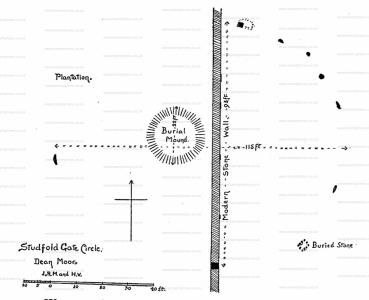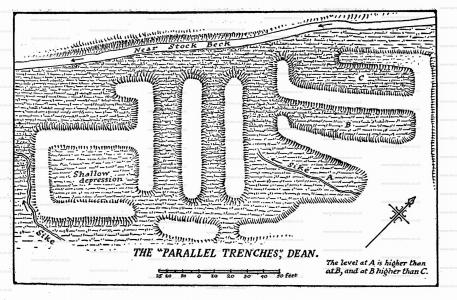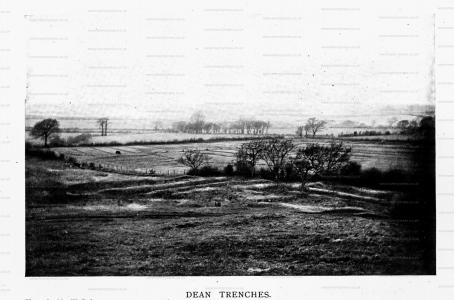Cumberland and Westmorland Antiquarian and Archaeological Society
Cumberland and Westmorland Antiquarian and Archaeological Society is in Victorian Books.
Cumberland and Westmorland Antiquarian and Archaeological Society, founded in 1866, is a local historical, antiquarian, archaeological and text publication society and registered charity covering the modern county of Cumbria.
CWAAS Transactions 1924 Volume 24
CWAAS Transactions 1924 Volume 24 Article IX
Article. IX.—Studfold Gate Circle And The Parallel Trenches At Dean. By J. R. Mason And H. Valentine. Read At The Sites, July 4th, 1924.
STUDFOLD GATE CIRCLE
This circle stands on Dean Moor at a height of about 650 feet above the sea and was first referred to by J. Clifton Ward (these Trans. o.s. iii. 247) and described by him as being in a ruinous state. Further reference has been made in Transactions N.S. xxiii, 34.
It is oval in form and measures 115 ft. by 93 ft. the longer axis pointing east and west. It is now cut through about the centre by a modern stone wall on the west side of which is a dense plantation. At the present time there are only 7 stones standing in the field, one of the largest being incorporated in the wall. The most northerly stone only showed slightly above the turf, but when bared it proved to be the largest of the group, measuring 4 ft. 7 ins. by 2 ft. 6 ins. Along the southern sweep of the circle was found, buried at a depth of 12 ins., another large block 36 ins. by 32 ins. There is only one stone standing in the plantation, but Mr. Robertson-Walker, the owner of the wooded half of the circle, distinctly remembers many more stones standing there.
More careful examination has revealed a slight mound (22 ft. in diameter) within the ring, which owing to the rough tangle of the wood had previously escaped notice. The mound was covered with thick spongy turf and the stones were only discovered by probing with a walking stick. An excavation was made at the top of the mound which showed that the stones had been carefully placed in position, and not just tipped in. On digging near the circumference three large flat slabs, one below the other,. were found and at the very bottom resting on the undisturbed soil, one larger still, 43 ins. by 24 ins. A further opening was made at another point which again revealed careful building, but in all three instances although we went down to the red clay, no remains of any kind. were found. Everything however pointed to the mound's having been used as a place of interment and that it had. evidently been rifled, possibly in very early times.

We were shewn by the forester a small mortar:and a good specimen of a stone axe-hammer 8 ins. long which:had been found in the village of Gilgarran about half-a-mile away.
Our thanks are due to Mr. A. Robertson-Walker for permission to dig, and also to Mr. R. E. Highton, the owner of the other part of the circle.


DEAN TRENCHES
During the Society's excursion to West Cumberland on July 4th, 1924, a visit was paid to Park Hill, Dean. This hill has the reputation locally of being the site of a Roman fort, but there is absolutely no foundation for this supposition, nor does it appear to have been a fort of any kind.
At the foot of the slope are the parallel trenches referred to by the late Mr. W. Dickinson (Trans. o.s. iii. 345). They are parallel excavations (see accompanying plan) but for what purpose they were constructed remains an enigma. They appear to be much later than the British period, and it has been suggested that they may have been medieval fish-ponds. Their water-logged condition and proximity to the old church and manor house give .colour to this view, but the theory is not completely convincing.
At the visit of the Society, Miss A. G. Gilchrist suggested that they had been osier-beds; and although osier-beds have not been noticed in the neighbourhood, the remark is worth consideration. At any rate the plan and view now offered may provide a record and material for discussion.
In the same field are the so-called archery butts, and near at hand was found the cup-and-ring-marked stone illustrated in these Transactions N.S. xxiii. 34.
